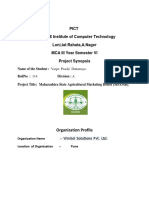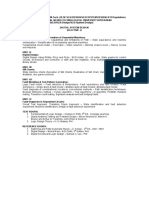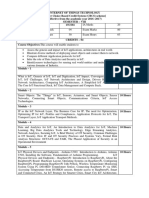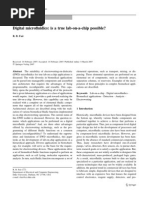0 ratings0% found this document useful (0 votes)
300 viewsE-Yantra Robotics Competition E-Yantra+ Caretaker Robot Theme
E-Yantra Robotics Competition E-Yantra+ Caretaker Robot Theme
Uploaded by
Mayank NagpalThe document describes an e-Yantra robotics competition where a team of 4 students from the Electronics and Communication department participated with their Firebird V robot. Their goal was to design a robot caretaker to autonomously deliver provisions to patients in a simulated hospital floor. The team's solution used image processing of the floor arena, Dijkstra's shortest path algorithm, and wireless communication to navigate the robot and complete tasks. They were ranked 4th out of 55 qualifying teams.
Copyright:
© All Rights Reserved
Available Formats
Download as PDF, TXT or read online from Scribd
E-Yantra Robotics Competition E-Yantra+ Caretaker Robot Theme
E-Yantra Robotics Competition E-Yantra+ Caretaker Robot Theme
Uploaded by
Mayank Nagpal0 ratings0% found this document useful (0 votes)
300 views7 pagesThe document describes an e-Yantra robotics competition where a team of 4 students from the Electronics and Communication department participated with their Firebird V robot. Their goal was to design a robot caretaker to autonomously deliver provisions to patients in a simulated hospital floor. The team's solution used image processing of the floor arena, Dijkstra's shortest path algorithm, and wireless communication to navigate the robot and complete tasks. They were ranked 4th out of 55 qualifying teams.
Original Description:
eyantra cargo theme
Original Title
vedvashu-Eyantra
Copyright
© © All Rights Reserved
Available Formats
PDF, TXT or read online from Scribd
Share this document
Did you find this document useful?
Is this content inappropriate?
The document describes an e-Yantra robotics competition where a team of 4 students from the Electronics and Communication department participated with their Firebird V robot. Their goal was to design a robot caretaker to autonomously deliver provisions to patients in a simulated hospital floor. The team's solution used image processing of the floor arena, Dijkstra's shortest path algorithm, and wireless communication to navigate the robot and complete tasks. They were ranked 4th out of 55 qualifying teams.
Copyright:
© All Rights Reserved
Available Formats
Download as PDF, TXT or read online from Scribd
Download as pdf or txt
0 ratings0% found this document useful (0 votes)
300 views7 pagesE-Yantra Robotics Competition E-Yantra+ Caretaker Robot Theme
E-Yantra Robotics Competition E-Yantra+ Caretaker Robot Theme
Uploaded by
Mayank NagpalThe document describes an e-Yantra robotics competition where a team of 4 students from the Electronics and Communication department participated with their Firebird V robot. Their goal was to design a robot caretaker to autonomously deliver provisions to patients in a simulated hospital floor. The team's solution used image processing of the floor arena, Dijkstra's shortest path algorithm, and wireless communication to navigate the robot and complete tasks. They were ranked 4th out of 55 qualifying teams.
Copyright:
© All Rights Reserved
Available Formats
Download as PDF, TXT or read online from Scribd
Download as pdf or txt
You are on page 1of 7
e-Yantra Robotics Competition
e-Yantra+ Caretaker Robot Theme
Team ID: eYRC+#925
Team Leader: Suvrat Shanker Chaturvedi
Team Members: 1) Suvrat Shanker Chaturvedi Electronics and Communication 2ND year
2) Ved Vasu Sharma Electronics and Communication 2ND year
3) Arun Soni Electronics and Communication 2ND year
4) Tushali Agarwal Electronics and Communication 2ND year
Position In the competition: participated in finals at IIT Bombay and ranked 4th in the theme out
of 55 qualifying teams.
About the Competition:
e-Yantra robotics competition is organized by IIT Bombay and supported by MHRD
Government of India. Main aim of the event is not competition but is to provide students
practical skill set which they acquire on their own by following the instructions of e-Yantra
team after months of hardwork. This year 495 teams were seleted to participate in the
competition. In eYRC+ Caretaker robot Theme 55 teams were selected for the second round out
of which 6 qualified for the finals at IIT Bombay.
About the eYRC+ Caretaker robot Theme:
e-Yantra Robotics Competition Plus has
designed a theme to bring our awareness to the
issue of catering to the needs of patients, for
example, automating the task of serving them,
even in the absence of human supervision.
In this theme, the arena is an abstraction of
a floor in a hospital, which includes a
Corridor, a Patient zone and a Service zone.
The robot is informed of the patients requests
via a computer that processes the images from
a camera and it autonomously seeks the
provisions to be picked up and delivered to the
corresponding patients.
Hardware and Software Specification:
4.1 Use of Firebird V robot:
- Firebird V robot based on Atmega2560 microcontroller is used for giving the solution for the
theme.
- The robot should be completely autonomous.
4.2 Components:
- 2 Zigbee modules for wireless communication and 3 RGB LEDs.
- Laptop/computer capable of running OpenCV and Python.
- iBall Robocam, web camera for capturing frames for image processing.
4.3 Software Specification:
- ATMEL STUDIO 6, a free software for programming AVR microcontroller or any other open
source Integrated Development Environment (IDE) for programming AVR microcontroller.
- OpenCV and Python to write their code.
Solution provided by us for the theme:
Our solution for the theme is based on single frame of reference that is we are taking a
single image at the starting of the task rather that that multiple images at different time
frames.
That image is processed by us to get a cropped arena clear with provision required and
provisions position. The bot position and orientation is also calculated using a python code.
The position coordinated of the demanded markers and provision markers is calculated
using the python code through Object detection technique.
Now we have Dijkstras Algorithm to calculate the shortest path in between the pair of
markers, bot and marker in the arena which in divided in grids with coordinates separated
by 40 pixels.
Now motion of the bot is invoked through the wireless communication as per the shortest
path calculated by Dijkstras algorithm.
Bot moves as per the specification specified in the embedded code.
Once the task is complete the python code stops and robot sounds a continuous buzzer
for 5 sec.
SCORECARD:
You might also like
- Lecture 2-2022 - Introduction To Software EngineeringDocument37 pagesLecture 2-2022 - Introduction To Software Engineeringpatriciaacquah30oNo ratings yet
- ED Module 1Document41 pagesED Module 1ನಂದನ್ ಎಂ ಗೌಡNo ratings yet
- Synopsis WSDocument11 pagesSynopsis WSNishit ChaudharyNo ratings yet
- HVPE Case StudyDocument23 pagesHVPE Case StudyNandit Bhardwaj100% (1)
- E Commerce An Indian Perspective by P T Joseph 8120327888 PDFDocument5 pagesE Commerce An Indian Perspective by P T Joseph 8120327888 PDFKARISHMA RAJNo ratings yet
- B. Discuss Key Enabling Technologies in Cloud Computing SystemsDocument3 pagesB. Discuss Key Enabling Technologies in Cloud Computing SystemsMuveenaNo ratings yet
- MEPE34 Additive Manufacturing: Dr. N. Siva ShanmugamDocument17 pagesMEPE34 Additive Manufacturing: Dr. N. Siva ShanmugamJoe AllanNo ratings yet
- CS3351 Digital Principles and Computer OrganizationDocument55 pagesCS3351 Digital Principles and Computer OrganizationvijayNo ratings yet
- TIME NotesDocument68 pagesTIME Notesrushikaurankar5No ratings yet
- Smart Leaf Infection Identification and FertilizerDocument3 pagesSmart Leaf Infection Identification and FertilizerJiiva GopiNo ratings yet
- Traffic Density Detection and Signal AdjustmentDocument13 pagesTraffic Density Detection and Signal AdjustmentRehan KhanNo ratings yet
- MefaDocument3 pagesMefaburgala vigneshNo ratings yet
- Electronic Commerce Framework Technologies and Applications by Bharat Bhasker B00syemujsDocument5 pagesElectronic Commerce Framework Technologies and Applications by Bharat Bhasker B00syemujsManoj BabaNo ratings yet
- Major Ilities of Avionics SystemDocument2 pagesMajor Ilities of Avionics SystemMoses RajasekaranNo ratings yet
- Eye BlinkDocument31 pagesEye BlinkPoorva Gupta67% (3)
- Students-Cisco-AICTE Internship 2023 Process Flow - Naan Mudhalvan PDFDocument15 pagesStudents-Cisco-AICTE Internship 2023 Process Flow - Naan Mudhalvan PDFJebisha JishNo ratings yet
- Brochure For Online FDP On Blockchain & Its Application From 04th - 10th May, 2020 PDFDocument2 pagesBrochure For Online FDP On Blockchain & Its Application From 04th - 10th May, 2020 PDFBapon100% (1)
- EngineeringDocument16 pagesEngineeringRajmchzNo ratings yet
- PPLE MERGED Notes+AssignmentDocument241 pagesPPLE MERGED Notes+Assignment302ABHISEK OMKAR PRASADNo ratings yet
- EEE 212 - Algorithms & Data Structures: Applications of Stacks (Continued)Document2 pagesEEE 212 - Algorithms & Data Structures: Applications of Stacks (Continued)bayentapasNo ratings yet
- DSP - Mod 6 PPT 1Document37 pagesDSP - Mod 6 PPT 1oxygen oxygenNo ratings yet
- Idt MCQ - QuestionsDocument3 pagesIdt MCQ - QuestionsKhader MohammedNo ratings yet
- Machine LearningDocument46 pagesMachine LearningCharmil Gandhi100% (1)
- Project Report Writing Notes For All UnitsDocument51 pagesProject Report Writing Notes For All Unitsbalajin142004No ratings yet
- File 5502 Workshop Brochure 1584345580Document2 pagesFile 5502 Workshop Brochure 1584345580jubairrubyNo ratings yet
- Translation Guideline (Equation) April2020Document26 pagesTranslation Guideline (Equation) April2020ameya1981No ratings yet
- Object Oriented Programming 600206 P.NITHYANANDAM. Asst - ProfessorDocument476 pagesObject Oriented Programming 600206 P.NITHYANANDAM. Asst - ProfessorVignesh WikiNo ratings yet
- Product Identification, Market Assessment, Creativity & Innovation Unit-1 (D)Document9 pagesProduct Identification, Market Assessment, Creativity & Innovation Unit-1 (D)Samman GuptaNo ratings yet
- Co Project: Edge Avoiding Robot USING 8051 MicrocontrollerDocument14 pagesCo Project: Edge Avoiding Robot USING 8051 MicrocontrollerJuthik BVNo ratings yet
- Stock Market Prediction Using Machine Learning Report 1Document36 pagesStock Market Prediction Using Machine Learning Report 1merijaanmohorNo ratings yet
- APMC Prachi SynopsisDocument6 pagesAPMC Prachi SynopsisAnuja J PatilNo ratings yet
- Engineering Graphics - Unit - 1 - Part 1Document41 pagesEngineering Graphics - Unit - 1 - Part 1SACHET GAJBHIYE100% (1)
- Crop Yield Prediction Using Deep Reinforcement Learning Model For Sustainable Agrarian ApplicationsDocument17 pagesCrop Yield Prediction Using Deep Reinforcement Learning Model For Sustainable Agrarian ApplicationsVirinchi ManepalliNo ratings yet
- Ethical Hacking Certification Training CourseDocument8 pagesEthical Hacking Certification Training CourseHadiya SarwathNo ratings yet
- ArmDocument46 pagesArmKarthik KarthiksNo ratings yet
- Interview Application FormDocument1 pageInterview Application FormjaslijasuNo ratings yet
- Markup, Markdown, Inventory ManagementDocument42 pagesMarkup, Markdown, Inventory ManagementhaslizanurNo ratings yet
- Optimizing Cost and Performance in MEAN Stack Applications with Cloud Auto-Scaling and Load BalancingDocument9 pagesOptimizing Cost and Performance in MEAN Stack Applications with Cloud Auto-Scaling and Load BalancingSMARTX BRAINSNo ratings yet
- Energy and EnvironmentDocument2 pagesEnergy and EnvironmentPhanindra ReddyNo ratings yet
- Alok Kumar MED Seminar Report (1805240902)Document26 pagesAlok Kumar MED Seminar Report (1805240902)Aditya KumarNo ratings yet
- Smart Traffic Lights Using Iottechnologies: Project Concept and ProgressDocument11 pagesSmart Traffic Lights Using Iottechnologies: Project Concept and ProgressIJAR JOURNALNo ratings yet
- DSDDocument1 pageDSDAnil MarturiNo ratings yet
- CPDP Study MaterialDocument169 pagesCPDP Study MaterialNenuNo ratings yet
- Faculty Profile PDFDocument5 pagesFaculty Profile PDFprathap021No ratings yet
- 8 CSE - GE8076 PEE Unit 1Document52 pages8 CSE - GE8076 PEE Unit 1DASARARAJU GNANENDRANo ratings yet
- Ai Unit-1 NotesDocument22 pagesAi Unit-1 Notes4119 RAHUL SNo ratings yet
- Name of The Project: Seminar Report ONDocument52 pagesName of The Project: Seminar Report ONAnonymous qh5UUGTNo ratings yet
- Get Electric Vehicles For Smart Cities: Trends, Challenges, and Opportunities Evanthia A. Nanaki PDF Ebook With Full Chapters NowDocument57 pagesGet Electric Vehicles For Smart Cities: Trends, Challenges, and Opportunities Evanthia A. Nanaki PDF Ebook With Full Chapters Nowaruqajfirhan64100% (3)
- Final BookDocument440 pagesFinal BookrazaraviNo ratings yet
- AIML Question Bank For Oral ExaminationDocument3 pagesAIML Question Bank For Oral ExaminationDon pablo100% (1)
- Fingerprint Based Electronic Voting MachineDocument20 pagesFingerprint Based Electronic Voting MachineAnjali yadavNo ratings yet
- 803 (A) Image Processing and Computer Vision#: Subject In-Charge: Prof Shilpa SharmaDocument44 pages803 (A) Image Processing and Computer Vision#: Subject In-Charge: Prof Shilpa SharmaShilpa SharmaNo ratings yet
- Seminar ReportDocument34 pagesSeminar Reportabhay Maurya100% (1)
- E-Waste Final DocumentationDocument37 pagesE-Waste Final DocumentationRam YadamaniNo ratings yet
- Machine Learning Applications-FDP-Updated SpeakerDocument5 pagesMachine Learning Applications-FDP-Updated SpeakerManojkumar VNo ratings yet
- Text Reader For Visually Impaired Person Using Image Processing Open-CVDocument8 pagesText Reader For Visually Impaired Person Using Image Processing Open-CVIJRASETPublicationsNo ratings yet
- Jahanzeb ThesisDocument31 pagesJahanzeb ThesisJahanzeb Khan Nizamani100% (1)
- B.E. (Automobile Engineering) - BitDocument246 pagesB.E. (Automobile Engineering) - BitMukharram KhanNo ratings yet
- 8th Sem Vtu SyllabusDocument15 pages8th Sem Vtu SyllabusshashankNo ratings yet
- CMOS Full Adder Circuit TopologiesDocument9 pagesCMOS Full Adder Circuit TopologiesAamodh KuthethurNo ratings yet
- Home (/) / / Newtec Battery Management System (BMS) Reference Design Designs (/Design/Designs:Refdsgnhome)Document7 pagesHome (/) / / Newtec Battery Management System (BMS) Reference Design Designs (/Design/Designs:Refdsgnhome)Madhusudanan AshokNo ratings yet
- Adaptive In-Conversation Team Building For Language Model AgentsDocument22 pagesAdaptive In-Conversation Team Building For Language Model AgentsgamininganelaNo ratings yet
- 2305 LecturesDocument1,155 pages2305 Lecturessongpengyuan123No ratings yet
- A Fast Method For Calculation of Transformers Leakage Reactance Using Energy Technique PDFDocument8 pagesA Fast Method For Calculation of Transformers Leakage Reactance Using Energy Technique PDFaocalayNo ratings yet
- CDAC Sample Questions AnswersDocument15 pagesCDAC Sample Questions AnswersPramod MahadikNo ratings yet
- Admin Assistant GS-4 LashioDocument2 pagesAdmin Assistant GS-4 LashionewarakanNo ratings yet
- Session01 Intro 2023 24Document59 pagesSession01 Intro 2023 24samireorucovaaNo ratings yet
- 12th Wss 241Document40 pages12th Wss 241sreejith9thattentiveNo ratings yet
- DP Books ListDocument19 pagesDP Books Listmonkiki9024No ratings yet
- Module 1 - Computer EthicsDocument19 pagesModule 1 - Computer EthicsJay BagayasNo ratings yet
- System Access Request Form v7 - New PDFDocument1 pageSystem Access Request Form v7 - New PDFMARK LAWRENCE DUMAGUINNo ratings yet
- University of GondarDocument67 pagesUniversity of GondarBelay WagawNo ratings yet
- Cullo - Ivy SCM Final ExamsDocument24 pagesCullo - Ivy SCM Final ExamsIvy CulloNo ratings yet
- Petroldatly 1Document2 pagesPetroldatly 1eagleayushku1234567890No ratings yet
- Documentation For This Question. Assumptions Can Be Made Wherever NecessaryDocument9 pagesDocumentation For This Question. Assumptions Can Be Made Wherever NecessaryShikha AgarwalNo ratings yet
- How To Cluster SQL Server Analysis ServicesDocument57 pagesHow To Cluster SQL Server Analysis ServicesBablu LawrenceNo ratings yet
- DolevDocument24 pagesDolevRobson SimoesNo ratings yet
- Whitepaper - DocuWare CloudDocument15 pagesWhitepaper - DocuWare CloudJosé MarínNo ratings yet
- Design & Analysis of Algorithms Mcs 031 Assignment FreeDocument15 pagesDesign & Analysis of Algorithms Mcs 031 Assignment Freecutehacker22No ratings yet
- Digital Microfluidics - Review - Fair - 2007Document37 pagesDigital Microfluidics - Review - Fair - 2007moifarmrjNo ratings yet
- Pagination Script and Tutorial For PHP MySQL Programmers Paging Results - Examples and Common Tasks in PHP PDFDocument4 pagesPagination Script and Tutorial For PHP MySQL Programmers Paging Results - Examples and Common Tasks in PHP PDFThomas ChinyamaNo ratings yet
- Final Exam IT Risk Man-2Document3 pagesFinal Exam IT Risk Man-2mohamed aliNo ratings yet
- COS60007 Assignment 1-2Document6 pagesCOS60007 Assignment 1-2SanamNo ratings yet
- BlackRock 2023-2024 Software Engineering Job DescriptionDocument1 pageBlackRock 2023-2024 Software Engineering Job DescriptionGamerizoneNo ratings yet
- Auto Hematology AnalyzerDocument6 pagesAuto Hematology AnalyzerzakariaNo ratings yet
- Configuration Samba Server File SharingDocument20 pagesConfiguration Samba Server File Sharingadu gNo ratings yet
- AssemblerDocument88 pagesAssemblerLee yi kangNo ratings yet
- Manual OP CO GEN Coin Acceptor NRI G-13mft ALL 2.1Document10 pagesManual OP CO GEN Coin Acceptor NRI G-13mft ALL 2.1elvis linaresNo ratings yet
- Impact of Social Media On PoliticsDocument7 pagesImpact of Social Media On PoliticsMilind SomanNo ratings yet

























































































